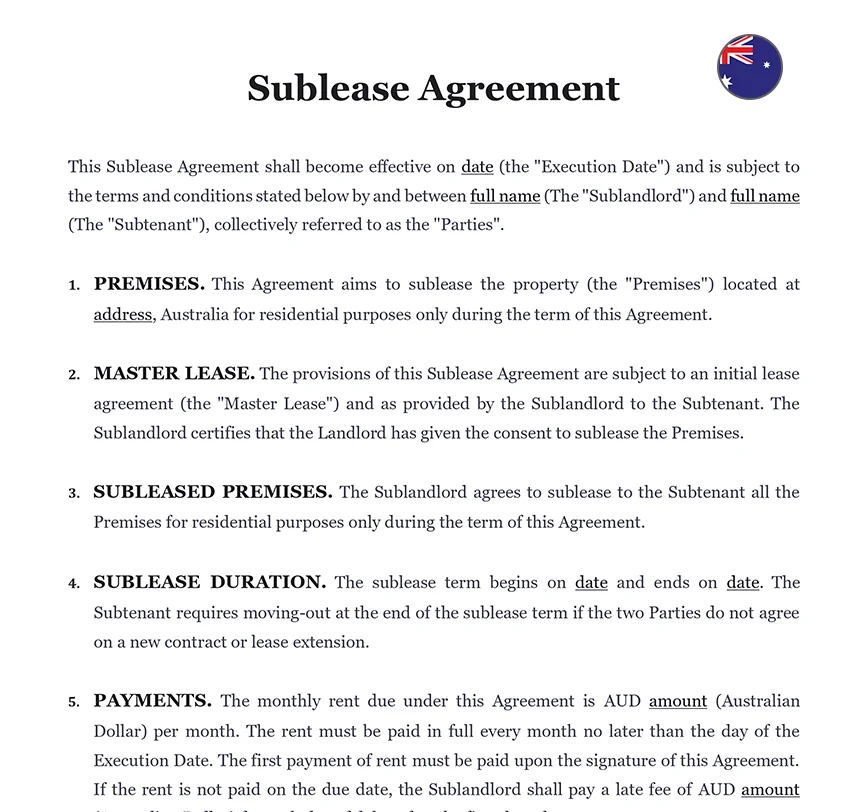Ready to use legal template
Drafted by experienced lawyers
Compliant with Australian law
Ready to use legal template
Drafted by lawyers
Compliant with Australian law
Home › Rent your property › Sublease agreement
Learn more about Sublease Agreement in Australia
In Australia, a Sublease Agreement is a legally binding contract between a tenant (the sublessor) and a third party (the sublessee) to lease all or part of a rented property. This agreement outlines the terms and conditions of the subleasing arrangement, including rent payments, responsibilities, and duration. It serves as an essential document to formalize the relationship between the parties involved and ensure clarity on rights and obligations. To facilitate this process and ensure compliance with Australian laws, we offer an easy-to-edit legal template meticulously crafted by legal experts, protecting the landlord’s property and seamlessly transferring responsibilities to the new tenant.
Table of contents
-
What is a Sublease Agreement and is it necessary?
-
What are my responsibilities as the sublessor in Australia?
-
Do I need permission from my landlord to sublease the property?
-
Can I set my own rental terms and conditions for the subtenant?
-
Am I still responsible for the property if I sublease in Australia?
-
Can I end the sublease agreement early if needed in Australia?
-
What happens if the subtenant damages the property?
-
Can I include utilities and other expenses in the sublease agreement?
-
What rights do I have as the primary tenant in a subleasing arrangement?
What is a Sublease Agreement and is it necessary?
A Sublease Agreement is a legal document that outlines the terms and conditions of a sublease arrangement between the original tenant (sublessor) and a new tenant (subtenant). It serves as a critical document to formalize the relationship between the sublessor and the subtenant, establishing the rights and obligations of each party regarding the subleased premises. The Sublease Agreement is necessary whenever the original tenant wishes to sublease the property to another party. It provides clarity and legal protection for both parties by defining the terms of the sublease, including rent payment, duration, permitted use of the premises, and any other relevant conditions.
ℹ️ Themis Partner also provides a professionally drafted Lease Agreement in order to comply with Australian Laws.
What are my responsibilities as the sublessor in Australia?
As the sublessor in Australia, you have several responsibilities to fulfill:
You must ensure that the sublease arrangement complies with the terms and conditions of the original lease agreement with the landlord.
Collecting rent from the subtenant and ensuring it is paid in accordance with the agreed-upon terms.
Maintaining the leased premises in a safe and habitable condition, including addressing any necessary repairs or maintenance promptly.
Complying with all relevant laws and regulations governing subleasing in Australia, including obtaining any necessary permissions or approvals from the landlord.
Providing the subtenant with access to the property and ensuring their right to quiet enjoyment of the premises.
It’s essential to review the terms of the Sublease Agreement carefully and fulfill your responsibilities to avoid any potential legal issues or disputes with the subtenant or the landlord.
Do I need permission from my landlord to sublease the property?
Yes, in most cases, you will need written permission from your landlord to sublease the property. Lease agreements typically include provisions that require the tenant to obtain the landlord’s consent before subleasing any portion of the leased premises. This requirement ensures that the landlord maintains control over who occupies the property and allows them to review the proposed sublease arrangement to ensure it complies with the terms of the original lease agreement. Failure to obtain permission from the landlord before subleasing may constitute a breach of the lease agreement and could result in legal consequences, including termination of the lease.
Can I set my own rental terms and conditions for the subtenant?
Yes, as the sublessor, you have the flexibility to set your own rental terms and conditions for the subtenant, subject to any restrictions or requirements outlined in the original lease agreement with the landlord. This includes determining the amount of rent, payment schedule, security deposit, and any other terms or conditions you wish to include in the Sublease Agreement. However, it’s crucial to ensure that your rental terms and conditions are fair, reasonable, and comply with relevant laws and regulations governing subleasing in Australia.
Am I still responsible for the property if I sublease in Australia?
Yes, as the sublessor, you remain responsible for the property under the terms of the original lease agreement with the landlord. This means that you are still liable for complying with the terms of the lease, maintaining the property, and addressing any issues or concerns that may arise during the sublease term. However, the Sublease Agreement may allocate certain responsibilities to the subtenant, such as paying rent and utilities, as agreed upon between you and the subtenant.
Can I end the sublease agreement early if needed in Australia?
In Australia, whether you can terminate the sublease agreement early will depend on the terms outlined in the Sublease Agreement and any applicable laws or regulations. The Sublease Agreement may include provisions specifying the circumstances under which the agreement can be terminated early and the procedures for doing so. This may involve providing notice to the subtenant within a specified timeframe and obtaining consent from the subtenant or following specific termination procedures outlined in the agreement.
What happens if the subtenant damages the property?
If the subtenant damages the property during the sublease term, the responsibility for addressing the damage will depend on the terms outlined in the Sublease Agreement and relevant laws or regulations. Generally, the sublessor (original tenant) remains ultimately responsible for the property under the terms of the original lease agreement with the landlord. However, the Sublease Agreement may allocate responsibility for repairing or compensating for damages caused by the subtenant to either the sublessor or the subtenant, depending on the circumstances and the provisions of the agreement. It’s essential to address any damage promptly and fairly to maintain a good relationship with the subtenant and fulfill your obligations as the sublessor.
Can I include utilities and other expenses in the sublease agreement?
Yes, as the sublessor, you can include utilities and other expenses in the Sublease Agreement, subject to negotiation and agreement between you and the subtenant. This may include allocating responsibility for paying for utilities such as electricity, water, gas, and internet services, as well as other expenses such as property taxes, maintenance costs, or common area charges. It’s essential to clearly specify the responsibilities of each party regarding expenses in the Sublease Agreement to avoid misunderstandings or disputes.
What rights do I have as the primary tenant in a subleasing arrangement?
As the primary tenant in a subleasing arrangement, you retain certain rights and responsibilities outlined in the original lease agreement with the landlord. These rights typically include:
| ➤ The right to collect rent from the subtenant and enforce the terms of the Sublease Agreement. |
| ➤ The right to enter into a legally binding contract with the subtenant, subject to any restrictions or requirements outlined in the original lease agreement. |
| ➤ The right to maintain control over the leased premises and ensure that the subtenant complies with the terms and conditions of the Sublease Agreement. |
| ➤ The right to seek legal recourse against the subtenant for any breaches of the Sublease Agreement or damage to the property. |
| ➤ It's essential to review your rights and responsibilities as the primary tenant in the Sublease Agreement and ensure that they align with the terms of the original lease agreement with the landlord. |




